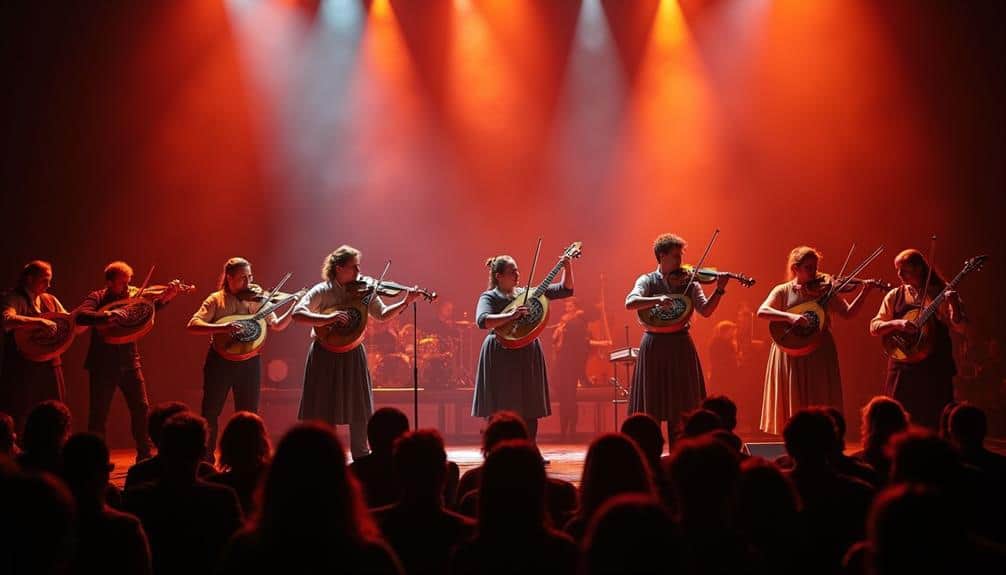The Origins of Balalaika

The balalaika, a quintessential symbol of Russian folk music, has a storied history that traces back to the 17th century. This unique, triangular-stringed instrument is not merely an artifact of cultural heritage but a reflection of the traditional craftsmanship that has persisted through generations.
Each balalaika is meticulously crafted, often by hand, reflecting the artisan’s dedication to preserving the instrument’s distinctive sound and aesthetic. The materials chosen, the thickness of the wood, and even the type of strings used are all integral components that influence its rich, resonant tones.
Regional variations in the construction and playing styles of the balalaika further enrich its history. In northern Russia, for instance, the instrument often features a more robust build, designed to withstand colder climates, whereas southern variants might be lighter and more ornate.
These differences also extend to the musical techniques employed by players across regions, creating a diverse auditory tapestry that is uniquely Russian. The balalaika’s enduring appeal lies in its ability to convey the profound cultural narratives of the areas from which it originates, encapsulating the spirit of Russian folk traditions within its simple yet evocative design.
Evolution Through the Ages
From its origins in the 17th century, the balalaika has undergone significant transformations, reflecting broader shifts in Russian society and culture.
Initially, this triangular, three-stringed instrument was rooted in folk traditions, serving as a staple at rural gatherings and celebrations. Its simple construction and ease of play made it accessible to the peasantry, embedding it deeply within the social fabric of Russian life.
As Russia entered the 19th century, the balalaika began to evolve, influenced by changing musical tastes and technological advancements.
Craftsmanship improved, leading to variations in size and tuning, thereby creating a family of balalaikas, each serving different musical functions. Regional variations emerged, as different areas adapted the instrument to their unique cultural contexts, resulting in diverse performance styles.
The Domra’s Legacy

Among Russia’s rich array of traditional instruments, the domra stands out for its significant historical and cultural impact. Originating in the 16th century, the domra has been a cornerstone of Russian musical heritage. Its unique sound and construction have played an essential role in shaping the country’s musical landscape.
The craftsmanship of the domra is a reflection of the skills and dedication of Russian artisans. Traditionally made from high-quality woods such as spruce or maple, the instrument features a rounded body and three or four metal strings. This meticulous attention to detail in domra craftsmanship guarantees that each instrument produces a resonant and distinct tone, distinguishing it from its contemporaries.
Historically, the domra found its place in both courtly and folk music, serving as an integral accompaniment in various performances. Its versatility allowed it to adapt to different musical genres, from lively dances to somber ballads, thereby leaving an indelible mark on Russian music.
The domra’s historical impact is further evidenced by its continued presence in modern orchestras and ensembles, bridging the past with the present and preserving a crucial link to Russia’s rich musical traditions.
Cultural Significance
In the tapestry of Russia’s cultural identity, the domra plays a pivotal role, symbolizing the nation’s deep-rooted musical traditions. This stringed instrument, with its origins possibly tracing back to the 16th century, is more than just a musical tool; it is a vessel of cultural expression that encapsulates the core of Russian folk traditions.
The domra’s simple yet resonant tones have historically been used to convey a wide array of human emotions, from sorrow to jubilation, reflecting the multifaceted nature of Russian life.
The domra’s cultural significance is deeply intertwined with its musical symbolism. Through its melodies, the domra tells stories of the Russian countryside, capturing the spirit of the people and their connection to the land. This instrument has been an integral part of folk ensembles, contributing to the preservation and dissemination of traditional Russian music.
Its presence in various ceremonies and communal gatherings underscores its role in fostering a sense of community and continuity.
Moreover, the domra serves as a bridge between past and present, reminding contemporary audiences of their heritage while inspiring new interpretations of age-old musical forms.
Famous Performers

Renowned musicians have elevated the domra to international acclaim through their exceptional artistry and dedication. Among these legendary virtuosos, Tamara Volskaya stands out with her unparalleled technique and expressive performances. A graduate of the Mussorgsky Ural State Conservatory, Volskaya has captivated audiences worldwide, showcasing the domra’s versatility and rich tonal qualities.
Her contributions have not only preserved the traditional repertoire but also expanded it through innovative interpretations.
Another seminal figure in the domra’s history is Aleksandr Tsygankov, whose virtuosic skill and pedagogical efforts have inspired generations of musicians. Tsygankov’s performances are marked by a profound emotional depth and technical precision, making him a revered figure in the world of Russian folk music.
In the domain of modern ensembles, the ensemble “Moscow Balalaikas” has played a pivotal role in popularizing the domra. This group, known for its dynamic arrangements and impeccable musicianship, seamlessly blends traditional folk melodies with contemporary influences, bringing the domra to new audiences.
Similarly, the “Terem Quartet” has made significant strides in integrating the domra into a diverse array of musical genres, thereby cementing its place in both classical and modern music spheres.
Contemporary Influence
The domra’s contemporary influence extends far beyond traditional Russian music, permeating various global music scenes. This ancient instrument, once confined to the domains of folklore, has found its voice in modern adaptations across genres such as jazz, rock, and even electronic music. Musicians today are pushing the boundaries of the domra’s capabilities, incorporating it into innovative compositions that resonate with a diverse, international audience.
A significant factor in this evolution is the rise of global collaborations. Artists from different countries and musical backgrounds are coming together, exploring the domra’s unique timbre to enrich their projects. For instance, the collaboration between Russian domra virtuosos and Western jazz ensembles has produced an eclectic fusion of sounds, showcasing the instrument’s versatility.
Such partnerships not only highlight the domra’s adaptability but also promote cultural exchange, fostering a deeper appreciation for its rich heritage.
Moreover, digital platforms and social media have played a pivotal role in the domra’s resurgence. Online tutorials and performances have made the instrument accessible to a global audience, inspiring a new generation of musicians.
Fundamentally, the domra’s journey from traditional to contemporary reflects a broader narrative of cultural preservation and innovation.




